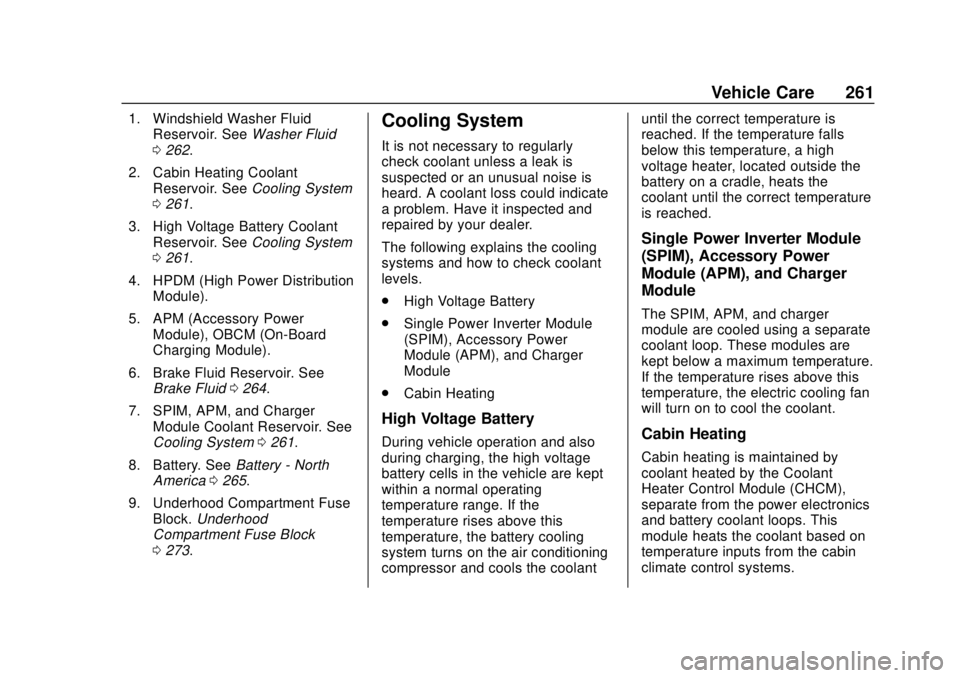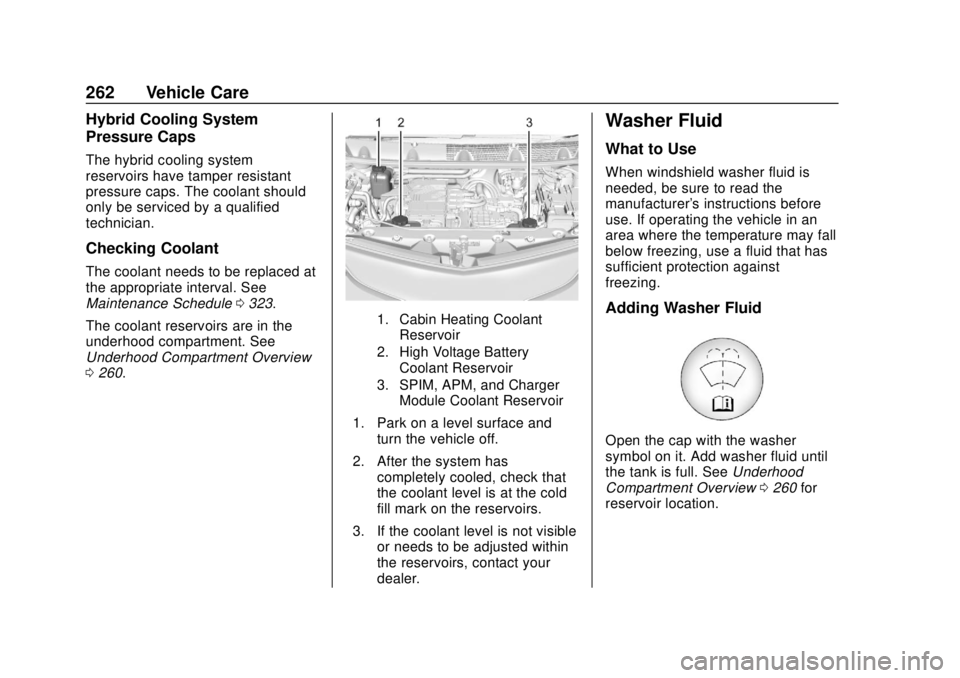2019 CHEVROLET BOLT EV coolant level
[x] Cancel search: coolant levelPage 262 of 371

Chevrolet BOLT EV Owner Manual (GMNA-Localizing-U.S./Canada/Mexico-
12163003) - 2019 - crc - 5/18/18
Vehicle Care 261
1. Windshield Washer FluidReservoir. See Washer Fluid
0 262.
2. Cabin Heating Coolant Reservoir. See Cooling System
0 261.
3. High Voltage Battery Coolant Reservoir. See Cooling System
0 261.
4. HPDM (High Power Distribution Module).
5. APM (Accessory Power Module), OBCM (On-Board
Charging Module).
6. Brake Fluid Reservoir. See Brake Fluid 0264.
7. SPIM, APM, and Charger Module Coolant Reservoir. See
Cooling System 0261.
8. Battery. See Battery - North
America 0265.
9. Underhood Compartment Fuse Block. Underhood
Compartment Fuse Block
0 273.Cooling System
It is not necessary to regularly
check coolant unless a leak is
suspected or an unusual noise is
heard. A coolant loss could indicate
a problem. Have it inspected and
repaired by your dealer.
The following explains the cooling
systems and how to check coolant
levels.
.
High Voltage Battery
. Single Power Inverter Module
(SPIM), Accessory Power
Module (APM), and Charger
Module
. Cabin Heating
High Voltage Battery
During vehicle operation and also
during charging, the high voltage
battery cells in the vehicle are kept
within a normal operating
temperature range. If the
temperature rises above this
temperature, the battery cooling
system turns on the air conditioning
compressor and cools the coolant until the correct temperature is
reached. If the temperature falls
below this temperature, a high
voltage heater, located outside the
battery on a cradle, heats the
coolant until the correct temperature
is reached.
Single Power Inverter Module
(SPIM), Accessory Power
Module (APM), and Charger
Module
The SPIM, APM, and charger
module are cooled using a separate
coolant loop. These modules are
kept below a maximum temperature.
If the temperature rises above this
temperature, the electric cooling fan
will turn on to cool the coolant.
Cabin Heating
Cabin heating is maintained by
coolant heated by the Coolant
Heater Control Module (CHCM),
separate from the power electronics
and battery coolant loops. This
module heats the coolant based on
temperature inputs from the cabin
climate control systems.
Page 263 of 371

Chevrolet BOLT EV Owner Manual (GMNA-Localizing-U.S./Canada/Mexico-
12163003) - 2019 - crc - 5/18/18
262 Vehicle Care
Hybrid Cooling System
Pressure Caps
The hybrid cooling system
reservoirs have tamper resistant
pressure caps. The coolant should
only be serviced by a qualified
technician.
Checking Coolant
The coolant needs to be replaced at
the appropriate interval. See
Maintenance Schedule0323.
The coolant reservoirs are in the
underhood compartment. See
Underhood Compartment Overview
0 260.
1. Cabin Heating Coolant
Reservoir
2. High Voltage Battery Coolant Reservoir
3. SPIM, APM, and Charger Module Coolant Reservoir
1. Park on a level surface and turn the vehicle off.
2. After the system has completely cooled, check that
the coolant level is at the cold
fill mark on the reservoirs.
3. If the coolant level is not visible or needs to be adjusted within
the reservoirs, contact your
dealer.
Washer Fluid
What to Use
When windshield washer fluid is
needed, be sure to read the
manufacturer's instructions before
use. If operating the vehicle in an
area where the temperature may fall
below freezing, use a fluid that has
sufficient protection against
freezing.
Adding Washer Fluid
Open the cap with the washer
symbol on it. Add washer fluid until
the tank is full. See Underhood
Compartment Overview 0260 for
reservoir location.
Page 277 of 371

Chevrolet BOLT EV Owner Manual (GMNA-Localizing-U.S./Canada/Mexico-
12163003) - 2019 - crc - 5/18/18
276 Vehicle Care
FusesUsage
42 Automatic occupant
sensing
43 Window switch
44 Rechargeable energy
storage system
45 Vehicle integration
control module
46 Integrated chassis
control module
47 Headlamp leveling
48 Integrated chassis
control module
49 Interior rearview
mirror
50 –
51 Electric brake boost
52 Rear camera
54 A/C control module
55 Rechargeable energy
storage system
coolant pump
56 – Fuses
Usage
57 Power electronics
coolant pump
58 Engine control module
59 Electric steering
column lock
60 HVAC electric heater
61 On-board charging
module
62 Transmission range
control module 1
63 Electric cooling fan
64 Engine control module
65 Auxiliary heater pump
67 Drive unit controller
68 Rear window
defogger
70 A/C control module
71 –
72 Transmission range
control module
73 Single power inverter
module Fuses
Usage
74 –
Relays Usage
53 Run/Crank
66 Powertrain
69 Second run/Crank
Page 325 of 371

Chevrolet BOLT EV Owner Manual (GMNA-Localizing-U.S./Canada/Mexico-
12163003) - 2019 - crc - 5/18/18
324 Service and Maintenance
Tire Rotation and Required
Services Every 12 000 km/
7,500 mi
Rotate the tires, if recommended for
the vehicle, and perform the
following services. SeeTire
Rotation 0292.
. Check coolant level. See
Cooling System 0261.
. Check windshield washer fluid
level. See Washer Fluid 0262.
. Check tire inflation pressures.
See Tire Pressure 0285.
. Inspect tire wear. See Tire
Inspection 0291.
. Visually check for fluid leaks.
. Inspect brake system. See
Exterior Care 0313.
. Visually inspect steering,
suspension, and chassis
components for damage,
including cracks or tears in the
rubber boots, loose or missing
parts, or signs of wear at least
once a year. See Exterior Care
0 313. .
Inspect power steering for
proper attachment, connections,
binding, leaks, cracks,
chafing, etc.
. Visually inspect halfshafts and
drive shafts for excessive wear,
lubricant leaks, and/or damage
including: tube dents or cracks,
constant velocity joint or
universal joint looseness,
cracked or missing boots, loose
or missing boot clamps, center
bearing excessive looseness,
loose or missing fasteners, and
axle seal leaks.
. Check restraint system
components. See Safety System
Check 070.
. Lubricate body components. See
Exterior Care 0313.
. Check accelerator pedal for
damage, high effort, or binding.
Replace if needed.
. Visually inspect gas strut for
signs of wear, cracks, or other
damage. Check the hold open
ability of the strut. If the hold open ability is low, service the
gas strut. See
Gas Strut(s)
0 268.
. Check tire sealant expiration
date, if equipped. See Tire
Sealant and Compressor Kit
0 299.
Page 326 of 371

Chevrolet BOLT EV Owner Manual (GMNA-Localizing-U.S./Canada/Mexico-
12163003) - 2019 - crc - 5/18/18
Service and Maintenance 325
Maintenance Schedule
Additional Required
Services12 000 km/7,500 mi
24 000 km/15,000 mi
36 000 km/22,500 mi
48 000 km/30,000 mi
60 000 km/37,500 mi
72 000 km/45,000 mi
84 000 km/52,500 mi
96 000 km/60,000 mi
108 000 km/67,500 mi
120 000 km/75,000 mi
132 000 km/82,500 mi
144 000 km/90,000 mi
156 000 km/97,500 mi
168 000 km/105,000 mi 180 000 km/112,500 mi
192 000 km/120,000 mi
204 000 km/127,500 mi
216 000 km/135,000 mi
228 000 km/142,500 mi
240 000 km/150,000 mi
Rotate tires and perform Required Services.@ @ @ @ @ @ @ @ @ @ @ @ @ @ @ @ @ @ @ @
Replace passenger compartment air filter. (1)@ @@@@@
Drain and fill vehicle coolant circuits. (2)@
Replace brake fluid. (3)
Replace windshield wiper blades. (4)
@ @ @ @ @ @ @ @ @ @
Replace hood and/or body lift support gas struts.@ @
Footnotes—Maintenance
Schedule Additional Required
Services
(1) Or every two years, whichever
comes first. More frequent
passenger compartment air filter
replacement may be needed if
driving in areas with heavy traffic,
poor air quality, high dust levels,
or environmental allergens.
Passenger compartment air filter
replacement may also be needed if
there is reduced airflow, window fogging, or odors. Your GM dealer
can help determine when to replace
the filter.
(2)
Or every five years, whichever
comes first. See Cooling System
0 261.
(3) Replace brake fluid every five
years. See Brake Fluid 0264.
(4) Or every 12 months, whichever
comes first. See Wiper Blade
Replacement 0267.Owner Checks and
Services
.
At least twice a year, have
underbody flushing service
performed. See "Underbody
Maintenance" in Exterior Care
0 313.